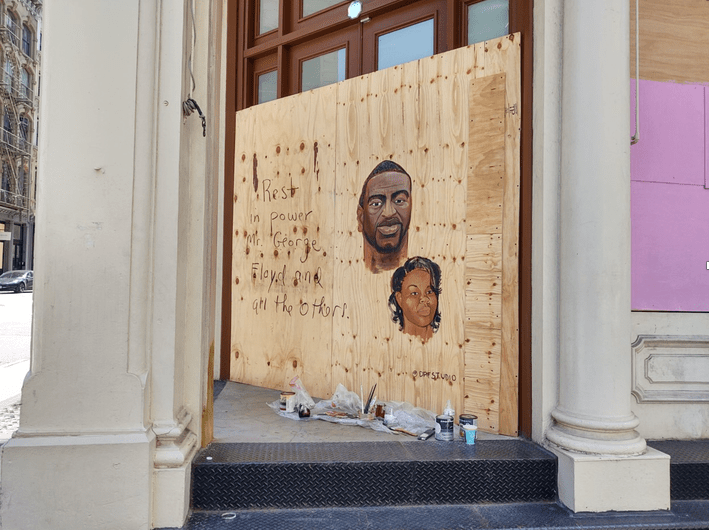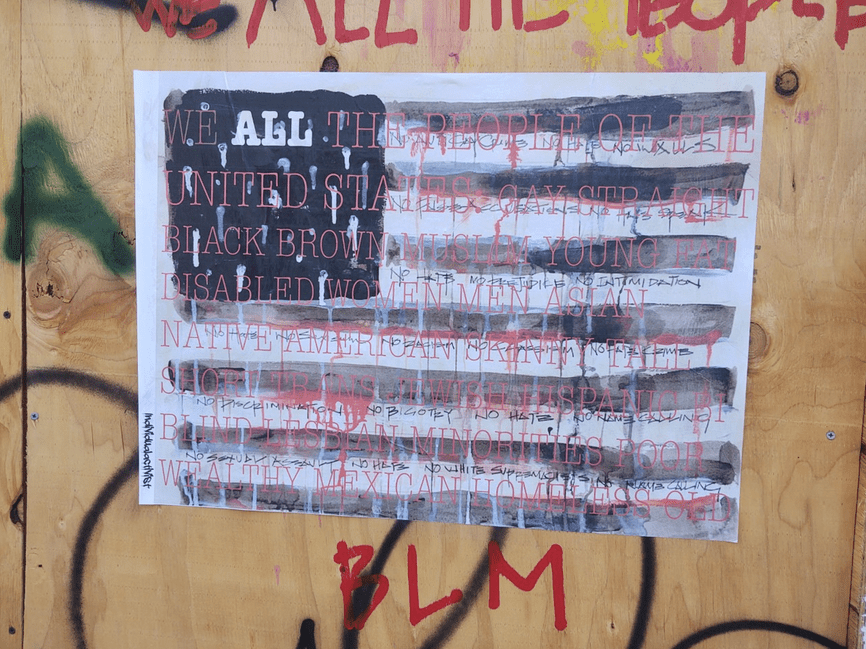Under the Burning Cop Cars, a Beach: A few brief observations on collective social collaging in New York City in the days following the killing of George Perry Floyd Jr.
By Ricardo Dominguez
Walls, windows, sidewalks, street lamps––anything became a potential site for the collective social collaging of street tags, posters, paintings and graffiti of pain, demands and hope for anti-racist streets, cities, nations and the planet after the killing of George Perry Floyd Jr. on May 25, 2020 by Minneapolis police. The streets in The Village (NYC) were flooded with protests day and night. The flows of communities in constant contestation in New York City created a palimpsestic layering of marking and unmarking, of making and unmaking, masking and unmasking of intersectional connections, of maps of actions already made and times for actions to be made. The city became a contagious calling out of the virus of racism during a global pandemic. Shouts ringing out of saying their names that echoed back that another world is possible. The kinopolitics of marching, blocking, trespassing, occupying and manifesting breathing spaces reiterated and expanded the Black Lives Matter (#BLM) movement into the largest U.S. non-violent direct action gathering in U.S. history.
These brief observations on collective social collaging are based on a few images I captured on my cell phone, along with images by poet-scholar Amy Sara Carroll, artist-activist Ian Alan Paul and filmmaker Césaire Carroll-Domínguez. We encountered them during the mornings after nights of past-curfew actions, while wandering on Broadway between Union Square and Houston, or on 2nd and 3rd Avenue, or on the way to protests at Washington Square Park, or during a Sunday afternoon walk in SoHo after everything was boarded up. Also included are images of #DefundPolice and #OccupyCityHall, which emerged a few weeks later.
#BrokenGlass #QuickTagging

The first night of actions that followed the murder of George Floyd focused on smashing the windows of specific storefronts, banks and drug stores on Broadway between 14th Street and Houston and quick tagging of “BLM” and #GeorgeFloyd (text/graffiti) on walls and windows. The collective social collage of gestures on the second night focused on breaking the windows of the same stores and banks, while bookstores, like The Strand on 13th Street and the nearby comic bookstore Forbidden Planet were left alone. The windows of The New School and New York University were not broken or tagged during any protest actions. So while media reports created a sense of random actions against property by protesters, at least on Broadway between Union Square on 14th street and Houston, this was not the case.



#DefundPopo
Over the next few days as the #CopRiots became more aggressive against #BLM protestors, the #DefundPoPo tags demanding the defunding of New York City police became almost as prominent as #GeorgeFloyd and #BLM. This became a national demand that in New York was guided by the Policing & Social Justice Project, organized by the City University of New York, which proposed a $1 billion cut to the NYPD budget over the next four years. The demand to #DefundPolice became a large part of actions in the days to come that would lead to #OccupyCityHall a few weeks after.



#QuoteTags #SoHo
After the third night of protests, stores started boarding up windows along Broadway and Houston. By the fourth night SoHo was boarded up and quickly became a major tagging zone. These gestures involved collaged images (including wanted posters of cops accused of killing black people), text (including quotes from radical black figures), #SayTheirNames posters, cartoons, paintings, and drawings with layers of graffiti overtop and underneath. A number of tags recalled that SoHo was now a “Big Business” that had killed art, and that its true aesthetic state was now blooming again. A number of tags in this area included artist’s signatures and websites.









 #ProtestPosters #OverThrow #TrumpIsNonEssential
#ProtestPosters #OverThrow #TrumpIsNonEssential
Crossing into the East Village, protest posters were the main form of collective social collaging. The layering effect followed the traditional ad campaigns that often cover the walls at various points between 2nd Ave. and 3rd Ave. on Bleecker Street. One specific wall was next to a boxing club called Overthrow New York that used the logo of the club as a way to establish support for the protests and anti-Trump sentiment. A few comments were layered on to the posters. One was a scribbled psychoanalytic reading of the cartoon figuration of Trump being punched by a boxing glove and also being attacked by an (American) eagle stating that “You don’t hate Trump, you hate Dad.” Another was a small black and white sticker satirizing the pandemic-economy practice of dividing people into “essential” or “non-essential” workers, which stated that “TRUMP is NON-ESSENTIAL”. Other posters asked the viewer “What are you fighting for?” and “Fight Supremacy.” These could be read in a number of ways, but the surrounding layers would lead one to consider fighting against the white supremacist ideology that informs much of the Trump Administration’s policies and rhetoric. Added to this social collage was the call for “Unity,” and for the establishment of individual social agency: “You Are an Instrument of Change,” echoing Gandhi’s oft-quoted “Be the change you wish to see in the world.”
Intersectional concerns were promoted on the next wall that were again connected to the boxing club. A large mural-like photograph of some Overthrow New York members gathered in front of the club with a large sticker stating “Keep the Kids, Deport the Racists.”
As one came to the end of the wall, three similar posters were pasted up in what seemed like a fashion image series or hip-hop LP cover of a black man being pushed into the hood of a car by two angry white riot cops as a large fire burns behind them. In all three posters a black man is smiling at his own double reflected back at him off the black shiny hood of a car with an almost jouissance-filled reaction to being arrested. This strange and startling textless image is inter-tagged into the arc of the Overthrow New York boxing club series.



#BlackWashing #Or #BLM
Along Bleecker and 2nd Ave the large corner store Kith and Kin had its windows broken over and over during the first three nights of protest. The windows were among the first to be boarded up east of Broadway. This was then followed on the fifth day with a large two-story text quote by Nelson Mandela. Commercial stores began to use the boarded-up space to place highly designed supportive statements, that had kinship with the Overthrow New York posters. These were attempts to ward off further protest actions against them and interpellate #BLM into a commercial space, which could be seen as a type of #BlackWashing (or perhaps the companies truly were supportive of #BLM). By the second week this type of response could be found on a large number of commercial stores in the area. #BLM support was not visible at any drugstores or banks along the same streets. In most cases, police presence was the dominant tactic for defending store fronts in this area.



#WashingtonSqArch #StolenLands #BloodySlavers
Tagging Washington Square Arch became a site of struggle between tagging, painting and police that made connections between U.S. histories of settler colonialism, the founding fathers being slave owners, and aggressive police protection of the monument. The splattering of red paint on the staute of George Washington created the most response from the authorities in terms of setting up barriers around the arch plus the addition of a large daily police presence for the weeks that followed.



#OccupyCityHall #AutonomousZone #AbolitionPark
On June 23rd, 2020, a few blocks away from Zuccotti Park, the site of the Occupy Wall Street protest camp in 2011, about a hundred people set up camp on a grassy area facing the east side of City Hall. #OccupyCityHall focused on the #BLM growing call to #DefundThePolice and put pressure on the City Council to cut the New York Police Department’s funding at an upcoming vote before the July 1st budget deadline. Soon, several hundred protestors gathered during the day, doing teach-ins, sharing food, bathroom location information and confronting riot police on the street between #OccupyCityHall and City Hall.
#OccupyCityHall also became a place for multiple resistance groups, communities and individuals from a wide variety of left ideological networks that unlike Occupy Wall Street were calling for a specific goal, #DefundPoPo, and for the redistribution of funds to much needed social support systems instead. Below are just a few images of all the signs and gestures that created the collective social collage against racism and police brutality (we did not take any images of the protestors for the protection of individuals participating in the occupation action). On June 30th the largest gathering took place as the City Council voted to shift almost $1 billion away from the New City Police Department budget. While many felt that it was not enough, a number of those occupying went back to other areas of the city to carry on the protests.
Several hundred people continue to occupy the grassy area that was renamed #AutonomousZone or #AbolitionPark, and which expanded the communal care system that had been established to address the needs of the houseless that also frequently come to the area for food and support. At 12:58 a.m. EST on Jul 22nd, 2020, NYPD in riot gear tore down #AbolitionPark with very little warning.
#BLM actions and protests continue to occur daily in many areas across the city, including Broadway between Union Square and Houston, the East Village, Washington Square Park and the SoHo area.






Ricardo Dominguez, a founding member of Critical Art Ensemble and an associate professor in the Visual Arts Department and a CalIT2/QI principal investigator at the University of California, San Diego. He is co-founder of Electronic Disturbance Theater 1.0, an artivist collective .that developed virtual sit-in technologies in solidarity with Zapatista communities in Chiapas, Mexico. With Brett Stalbaum, micha cardenas, Amy Sara Carroll and Elle Mehrmand he co-created Electronic Disturbance Theater 2.0 and co-produced the Transborder Immigrant Tool (https://tbt.tome.press/). He also is co-founder of *particle group*, with artists Diane Ludin, Nina Waisman, Amy Sara Carroll, whose art project about nano-toxicology is entitled *Particles of Interest: Tales of the Matter Market* (http://archive.hemisphericinstitute.org/hemi/en/particle-group-intro).








